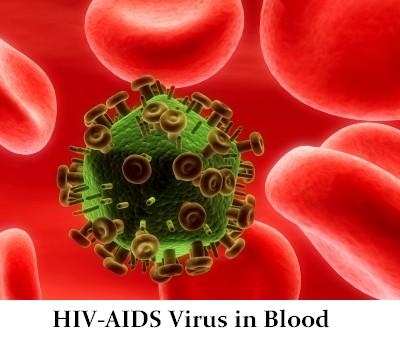- Updated on October 31, 2019
![]() By Dr. Artour Rakhimov, Alternative Health Educator and Author
By Dr. Artour Rakhimov, Alternative Health Educator and Author
 While this was a small clinical trial on people with HIV-AIDS, it was the most successful trial in the history of HIV-AIDS research. What were the reasons for its appearance?
While this was a small clinical trial on people with HIV-AIDS, it was the most successful trial in the history of HIV-AIDS research. What were the reasons for its appearance?
Any HIV-AIDS therapy, in order to be successful and efficient, should include breathing retraining, in addition to accepted practices of medication use, so as to improve body-O2 content using breathing exercises and natural lifestyle correction (learning diaphragmatic breathing, prevention of mouth breathing during sleep, physical exercise with nose breathing only, etc.). Such an approach allows faster improvements in the parameters of the immune system to fight the HIV virus and improve digestion, sleep, and desire and tolerance to exercise.
Clinical evidence of doctors, as well as available physiological studies, found that advance of HIV-AIDS is always manifested in reduced cell oxygenation. See this page for details: HIV-AIDS and low body O2. Decades of medical research revealed hundreds of pathological effects of chronic hyperventilation that is present even in modern normal subjects (see the Homepage).
Is there any western published evidence that HIV-AIDS sufferers breathe heavier during the progression of the disease? I could not find any studies that had measured minute ventilation numbers provided, but there are other publications were respiratory frequency and heart rates were reported.
In one study, Canadian doctors from St Paul’s Hospital (University of British Columbia, Vancouver) discovered that corticosteroids reduced initial breathing rates from 30 to 22 breaths/min at rest (Montaner et al, 1993). Hence, the initial breathing frequency in these HIV-AIDS patients was about 30 breaths per minute (the normal range is 10-12 breaths per min at rest). It corresponds to about 5 s for the body-oxygen test and the last stage of the disease (the terminal stage). After application of cortisol, their breathing became slower (22 breaths/min), which according to the Buteyko Table of Health Zones is over 15 s, which corresponds to mild forms of the disease.
 In another study, a group of Chinese MDs used oxygen-enriched liquid to reduce low blood oxygenation in patients with SARS and HIV-AIDS virus. Their initial respiratory rate ranged from 29 to 49 breaths per minute (less than 6 s for the body-oxygen test). Hence, HIV-AIDS patients do indeed suffer from very heavy breathing during the last stage of the disease.
In another study, a group of Chinese MDs used oxygen-enriched liquid to reduce low blood oxygenation in patients with SARS and HIV-AIDS virus. Their initial respiratory rate ranged from 29 to 49 breaths per minute (less than 6 s for the body-oxygen test). Hence, HIV-AIDS patients do indeed suffer from very heavy breathing during the last stage of the disease.
Therefore, heavy breathing is the cause of HIV-AIDS, and medical studies indeed point out that hypoxia is a normal clinical feature in HIV-AIDS patients (follow the link for research studies). Chronic hyperventilation immediately leads to a cascade of pathological changes in the lung tissue due to alveolar hypocapnia (CO2 deficiency) and equally injurious effects in all vital organs and body cells. These effects are summarized on web pages devoted to CO2 uses in the human body.
Furthermore, such respiratory disturbances (e.g., very fast breathing, quick and forceful exhalations, the absence of the automatic pause after the exhalation, etc.) should cause reduced nitric oxide production and absorption, as it was reported by US scientists from the Oregon Health Sciences University in Portland (Loveless et al, 1997).
Clinical Trial: Application of the Buteyko breathing therapy for HIV-AIDS patients
In the early 1990s, a large group of Russian and Ukrainian MDs organized a clinical trial for 7 people with the advanced HIV-AIDS disease. Here are the main trial’s conclusions:
– 1. The use of the Buteyko method has resulted in improvements in clinical symptoms.
– 2. No side-effects or complications have been observed in patients with AIDS during the Buteyko therapy.
– 3. It is sensible to continue careful observations and laboratory investigations of AIDS patients and recommend the Buteyko method for further testing.
– 4. Regular psychotherapy that had been used earlier proved ineffective and the health state of four patients even worsened.
Here are the translation of the clinical trial and an official letter to the Deputy Minister of Health of Ukrainian SSR about this HIV-AIDS clinical trial.
Usual CP (body-oxygen content) numbers in HIV-AIDS patients
What are the usual CP numbers (oxygenation index) for HIV-AIDS patients and their clinical features?
1-10 s of oxygen in body cells – HIV wasting syndrome, pneumocystis pneumonia, Kaposi sarcoma, candidiasis of trachea, chronic herpes simplex infection, recurrent severe bacterial pneumonia, progressive multifocal leukoencephalopathy, disseminated non-tuberculous mycobacteria infection, bronchi and/or lungs, extrapulmonary cryptococcosis including meningitis, HIV encephalopathy, chronic isosporiasis, chronic cryptosporidiosis, lymphoma (cerebral or B cell non-Hodgkin), invasive cervical carcinoma, extrapulmonary histoplasmosis, coccidiomycosis, recurrent septicaemia (including non-typhoidal Salmonella), symptomatic HIV-associated nephropathy or HIV-associated cardiomyopathy
10-20 s – Fatigue, mouth ulcers, skin rashes, night sweats, moderate digestive complaints, and fungal skin infections. Typical problems are recurrent herpes blisters on the mouth (cold sores) and/or genitals, chronic oral and/or vaginal thrush (a fungal rash or spots), ongoing fevers, persistent diarrhea, and weight loss
Over 25 s – No need for medication and no major symptoms
Over 40 s CP 24/7 – Normal health, including blood tests, various parameters of the immune system, digestion and mental well being.
 Note that the CP fluctuates throughout the day and the most important result is immediately after waking up in the morning. This is exactly the most miserable time for patients with HIV-AIDS virus, while other severely sick patients (those with stroke, coronary heart disease, epilepsy, COPD, diabetes, asthma, etc.) are most likely to die during early morning hours due to severe overbreathing and critical oxygenation numbers.
Note that the CP fluctuates throughout the day and the most important result is immediately after waking up in the morning. This is exactly the most miserable time for patients with HIV-AIDS virus, while other severely sick patients (those with stroke, coronary heart disease, epilepsy, COPD, diabetes, asthma, etc.) are most likely to die during early morning hours due to severe overbreathing and critical oxygenation numbers.
The natural and stress-free CP test is invaluable in numerous situations. One can check the effects of various factors, including allergies, nutritional deficiencies, exercise, etc. To increase tissue oxygen content and the CP (stress-free breath holding time after exhalation) are the central goals of the Buteyko breathing method.
What reduces the body-oxygen content in people with HIV-AIDS? The main physiological factors are the same as for ordinary people: sleeping too long and/or on the back, overeating, overheating, stress, a lack of physical activity, exercise with mouth breathing, poor posture, and many others. All these factors make respiration more frequent and heavier causing losses of CO2 and this is the key factor that triggers negative effects of chronic diseases, including cell hypoxia and suppressed immune system, the key hallmarks of advancing HIV-AIDS.
All HIV-AIDS web pages:
HIV AIDS overview
HIV-AIDS Clinical Trial – Breathing exercises reverse typical signs and symptoms of advanced HIV-AIDS.
HIV-AIDS Cause – Suppression of the immune system can take place only due to low oxygen levels in body cells. Tissue hypoxia, due to abnormal breathing in people with HIV-AIDS, is the cause
HIV-AIDS studies about low body O2
HIV-AIDS Therapy – Improve body oxygenation with breathing retraining.

